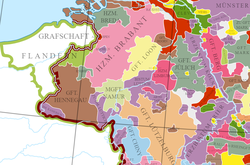
Back كونتية لون Arabic Графство Лоон Bulgarian Comtat de Loon Catalan Grafschaft Loon German Condado de Loon Spanish Comté de Looz French Greefskip Loan Frisian Contea di Loon Italian Graafsjap Loeën LI Loono grafystė Lithuanian
County of Loon | |||||||||
|---|---|---|---|---|---|---|---|---|---|
| 1040–1795 | |||||||||
 The Low Countries around 1250, Loon in yellow | |||||||||
| Status | State of the Holy Roman Empire | ||||||||
| Capital | Borgloon Hasselt | ||||||||
| Common languages | Limburgish | ||||||||
| Religion | Roman Catholicism | ||||||||
| Government | County | ||||||||
| Historical era | Middle Ages | ||||||||
• First mentioned | 1040 | ||||||||
• Gained Rieneck | 1106 | ||||||||
• Acquired Chiny | 1227 | ||||||||
• To Heinsberg | 1336 | ||||||||
• Incorporated by Liège | 1366 | ||||||||
| 1795 | |||||||||
| |||||||||
The County of Loon (Dutch: Graafschap Loon [ˈɣraːfsxɑp ˈloːn], Limburgish: Graafsjap Loeën [ˈɣʀaːfʃɑp ˈluən],[tone?] French: Comté de Looz) was a county in the Holy Roman Empire, which corresponded approximately with the modern Belgian province of Limburg. It was named after the original seat of its count, Loon, which is today called Borgloon. During the middle ages the counts moved their court to a more central position in Kuringen, which today forms part of Hasselt, capital of the province.
From its beginnings, Loon was associated with the nearby Prince-bishop of Liège, and by 1190 the count had come under the bishop's overlordship.[1] In the fourteenth century the male line ended for a second time, at which point the prince-bishops themselves took over the county directly. Loon approximately represented the Dutch-speaking (archaic French: thiois) part of the princedom. All of the Dutch-speaking towns in the Prince-Bishopric, with the status of being so-called "Good Cities" (French: bonnes villes), were in Loon, and are in Belgian Limburg today.[2] These were Beringen, Bilzen, Borgloon, Bree, Hamont, Hasselt, Herk-de-Stad, Maaseik, Peer and Stokkem.
Like other areas which eventually came under the power of the Prince Bishop of Liège, Loon never formally became part of the unified lordship of the "Low Countries" which united almost all of the Benelux in the late Middle Ages, and continued to unite almost all of today's Belgium under the ancien regime. Loon and other Liège lordships only joined their neighbours when they all became part of France during the French Revolution. After the Battle of Waterloo, they remained connected in the new United Kingdom of the Netherlands. In 1839, the old territory of Loon became the approximate basis of a new province, Limburg, within the new Kingdom of Belgium.

- ^ Count Gerard of Loon declared himself to hold Loon of the Bishop, in an Imperial Diet. See Vaes pp.32-3.
- ^ See for example Vaes p.119. The Dutch speaking cities were specifically called the cités thioises, where "thioise" is an old word related to English "Dutch".
